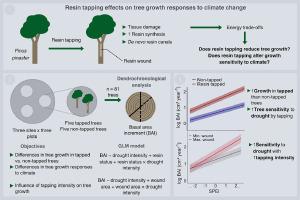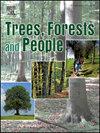历史上的森林使用限制了树木生长对干旱的反应:关于攻丝海松(Pinus pinaster)的案例研究
IF 2.7
Q1 FORESTRY
引用次数: 0
摘要
在 20 世纪的大部分时间里,从松脂树(海松树)中提取树脂是地中海森林的一项重要经济活动,直到 20 世纪 60-70 年代树脂价格下降导致人们放弃这项活动。在长期采脂之后,树木的生长通常会减弱,但这些曾经采脂的林分对近期气候变暖和干旱化的反应如何还不得而知。我们在西班牙东部的特鲁埃尔(Teruel)采集了三个历史上曾被采脂的海洋松林样本,以了解采脂和未采脂树木的不同生长情况以及对气候的反应。我们利用树木年代学方法,比较了出土和未出土树木的生长趋势以及对气候的反应。总体而言,攻丝树木的生长速度高于未攻丝树木,因为未攻丝树木通常更年轻。然而,随着时间的推移,树木的生长速度减慢,增加了晚春气温、夏季干旱和夏季降水量减少的负面影响。我们的研究结果表明,以往管理的遗留影响会增加树木生长对干旱的敏感性,从而制约树木对气候变化的反应。本文章由计算机程序翻译,如有差异,请以英文原文为准。

Historical forest use constrains tree growth responses to drought: A case study on tapped maritime pine (Pinus pinaster)
Resin extraction from Pinus pinaster (maritime pine) trees was an important economic activity for most of the 20th century in Mediterranean forests, until the decrease in resin prices that led to their abandonment in the 1960s-1970s. Reduced tree growth is often observed after long periods of resin tapping, but it is unknown how these formerly tapped stands respond to recent climate warming and aridification. We sampled three historically tapped maritime pine stands in Teruel, eastern Spain, to understand differential growth and responses to climate in resin tapped and non-tapped trees. Using dendrochronological methods, we compared tree growth trends and responses to climate in tapped and non-tapped trees. Overall, tree growth was higher in resin tapped trees than in non-tapped trees, which were generally younger. However, tree growth decreased over time, increasing the negative effects of late spring temperatures, summer drought and reduced summer precipitation, with increased sensitivity to drought in tapped than non-tapped trees. Among tapped trees, those with larger wound area grew more than those less tapped, and were more sensitive to drought, particularly after the 80 s. Our results suggest that the legacy effects of previous management can constrain tree responses to climate change by increasing the sensitivity of tree growth to drought.
求助全文
通过发布文献求助,成功后即可免费获取论文全文。
去求助
来源期刊

Trees, Forests and People
Economics, Econometrics and Finance-Economics, Econometrics and Finance (miscellaneous)
CiteScore
4.30
自引率
7.40%
发文量
172
审稿时长
56 days
 求助内容:
求助内容: 应助结果提醒方式:
应助结果提醒方式:


